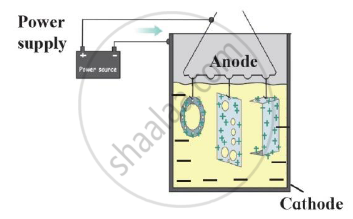Advertisements
Advertisements
Question
What is done to prevent corrosion of metals?
Solution
We can prevent corrosion by selecting the following things:
- Metal Type:
One simple way to prevent corrosion is to use a corrosion-resistant metal such as aluminium or stainless steel. Depending on the application, these metals can be used to reduce the need for additional corrosion protection. - Protective Coatings:
- The application of a paint coating is a cost-effective way of preventing corrosion. Paint coatings act as a barrier between the metal and atmospheric moisture to avoid its contact. For example: black paint.
- Another possibility is applying a powder coating. In this process, a dry powder is applied to the clean metal surface to avoid its contact with surrounding oxygen. For example: acrylic, polyester, epoxy, nylon and urethane.
- Environmental Measures: Corrosion is caused by a chemical reaction between the metal and gases in the surrounding environment. By taking measures to control the environment, these unwanted reactions can be minimized. For example: this would be decreased by treating the water in water boilers with softeners to adjust hardness, alkalinity or oxygen content.
- Sacrificial Coatings: Sacrificial coating involves coating the metal with an additional metal type that is more likely to oxidize. There are two main techniques for sacrificial coating:
- Cathodic Protection: The most common example of cathodic protection is the coating of iron alloy steel with zinc, this process is known as galvanizing. Zinc is a more active metal than steel and when it starts to corrode it oxides which inhibits the corrosion of the steel. This method is known as cathodic protection
- Anodic Protection: Anodic protection involves coating the iron alloy steel with a less active metal, such as tin. The tin will not corrode, so the steel will be protected as long as the tin coating is in place. This method is known as anodic protection.
- Design Modification: Design modifications can help reduce corrosion and improve the durability of any existing protective anti-corrosive coatings. Ideally, designs should avoid trapping dust and water, encourage the movement of air, and avoid open crevices. Ensuring the metal is accessible for regular maintenance will also increase longevity.
RELATED QUESTIONS
What is meant by 'rusting of iron'? With the help of labelled diagrams, describe an activity to find out the conditions under which iron rusts.
What is corrosion? What are necessary conditions for corrosion?
State under what conditions corrosion is faster ?
Identify the process shown in the diagram and explain it in short

Stainless steel is an alloy of _______.
Write scientific reason.
Anodization method is useful for prevention of the corrosion of the aluminium.
State two conditions necessary for rusting of iron.
The table shown below gives information about four substances: A, B, C and D.
| SUBSTANCE | MELTING POINT (K) | ELECTRICAL CONDUCTIVITY | |
| SOLID | LIQUID/ AQUEOUS | ||
| A | 295 | Good | Good |
| B | 1210 | Poor | Good |
| C | 1890 | Poor | Good |
| D | 1160 | Poor | Poor |
Identify Ionic compounds from the above given substances.
Give scientific reasons.
Silver amalgam is used for filling dental cavities.
| A process of forming a thick oxide of aluminium when aluminium is exposed to air. This coat makes it resistant to corrosion. Resistance can be improved by making a layer of oxide thinker. In this technique, the aluminium article is the anode, and the electrolyte is sulphuric acid. The anode reaction results in the formation of a black-coloured film of aluminium oxide on the anode. By putting appropriate dyes in the electrolytic solution, both coloured surface with the decorative finish is achieved. Kitchen articles like anodised such as pressure cookers, pans and frames of sliding windows are applications of this technique. |
- Name the anode and electrolyte used in this technique.
- How can we make aluminium articles made resistant to corrosion?
- Name the technique used to coat the aluminium articles.
